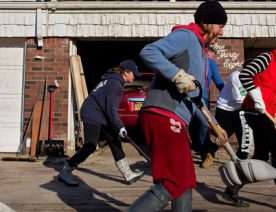
In the United States, there is growing awareness of and attention to the tremendous, lasting damage and loss of life in communities affected by natural disasters. This attention brings the topics of preparedness, response, and recovery to the fore. Central to these discussions is resilience: how and why some individuals, and some communities, recover more quickly and more effectively than others in the face of a
natural disaster.
Striking landfall in the United States on October 29, 2012, Superstorm Sandy affected large areas of coastal New York and New Jersey, devastated communities, killed more than 130 people, and caused tens of billions of dollars in property damage. The impacts of the storm are still being felt in many communities today as the long recovery process continues. The high level of damage and often slow recovery from natural disasters such as Superstorm Sandy are causing policymakers, emergency managers, and local leaders to ask: what characteristics of a community make it more resilient, and thus better able to effectively respond?
The economic development and physical infrastructure of a community are substantial factors in its resilience. However, recovery rates often differ in adjacent communities and neighborhoods with similar economic and structural resources. Not as visible, but arguably just as tangible, are social resources that can be critical to response and recovery efforts. Indeed, extant literature suggests that factors such as social network connectedness, social cohesion, trust, and community bonds facilitate social interaction and information exchange. This reservoir of social resources can then be drawn upon in the event of a disaster.
With funding from the Rockefeller Foundation, the Associated Press—NORC Center for Public Affairs Research conducted a national survey of 2,025 individuals including an oversample of 1,007 interviews with residents in the NY and NJ region affected by Superstorm Sandy.
The survey had two central objectives:
- To systematically measure the impact of the storm on individuals and neighborhoods and to assess the level of recovery six months after the storm.
- To learn how neighborhood characteristics and social factors relate to recovery and resilience.



